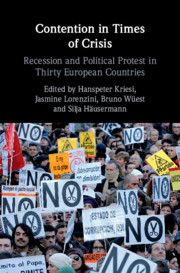Book contents
- Contention in Times of Crisis
- Contention in Times of Crisis
- Copyright page
- Contents
- Figures
- Tables
- Contributors
- Preface and Acknowledgements
- Part I A Study of Protest in Thirty European Countries
- Part II Trends in Protest in the Great Recession
- 4 Overall Trends of Protest in the Great Recession
- 5 All Quiet on the Protest Scene?
- 6 The Return of the Economy?
- Part III Sources of Protest
- Part IV Interaction Between Convention and Contention
- References
- Index
4 - Overall Trends of Protest in the Great Recession
from Part II - Trends in Protest in the Great Recession
Published online by Cambridge University Press: 13 August 2020
- Contention in Times of Crisis
- Contention in Times of Crisis
- Copyright page
- Contents
- Figures
- Tables
- Contributors
- Preface and Acknowledgements
- Part I A Study of Protest in Thirty European Countries
- Part II Trends in Protest in the Great Recession
- 4 Overall Trends of Protest in the Great Recession
- 5 All Quiet on the Protest Scene?
- 6 The Return of the Economy?
- Part III Sources of Protest
- Part IV Interaction Between Convention and Contention
- References
- Index
Summary
There was no European-wide wave of protest triggered by the Great Recession. Instead, a protest wave swept across southern Europe, which was, however, mainly due to the developments in Greece. In Greece, the crisis gave rise to a sustained wave of protest that covered both the shock- and the Euro-crisis period. But even in the case of Greece, this wave had already been under way once the economic crisis really hit the country. Moreover, while the crisis also gave rise to protest waves in Cyprus, Portugal, and Spain during the Euro-crisis, it did not do so in all southern European countries. There were no waves to speak of in Italy and Malta during any part of the Great Recession. In north-western Europe, with the exception of Iceland and the UK, protest seems to have developed largely independently of the economic crisis, while we have found some country-specific waves in central- and eastern Europe. But the eastern European waves, too, had either already accelerated before the intervention of the Great Recession, which only contributed to their peaks (Latvia, Lithuania), delayed their decline (Czech Republic, Hungary), or was actually unrelated to the protest (Bulgaria, Estonia). A lot of protest during the Great Recession responded to country-specific conditions which were entirely unrelated to the crisis.
Keywords
- Type
- Chapter
- Information
- Contention in Times of CrisisRecession and Political Protest in Thirty European Countries, pp. 77 - 103Publisher: Cambridge University PressPrint publication year: 2020
- 1
- Cited by



